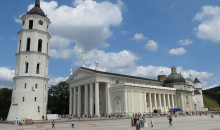
The Lithuanian Economy: Lessons Learned From the Crisis

The global financial crisis that hit the Lithuanian economy in 2008 that was not particularly prepared. A price bubble formed in the real estate market from 2004-2007, which led to the overheating of the construction sector. The credit policies of banks was oriented at encouraging this part of the sector, which led to the particularly quick rates of GDP growth, however after the crisis started, many households and businesses could not carry out their financial obligations.
The market cycle only deepened the procyclicality of economic policy – right before the 2008 parliamentary elections, a populist decision was adopted to increase retirement pensions, which a few months later had to be retracted and cut social benefits. Not only was precious time lost in implementing reforms but also the trust of investors and the people in the social security system.
Already on the eve of the crisis, the government was taking steps to cool the real estate market, for example by getting rid of tax incentives for buying a home. However the main decisions to stabilize the economy were to be taken in 2009-2010. Taxes were raised and public expenditure was slashed. Though this policy is subject to debate today, it helped to lessen the state’s dependence on loans and created a form macroeconomic foundation for developing the country’s business.
After the end of the crisis, the export sector was the one that best guaranteed a rise in GDP. A fair amount of hope to get the construction and real estate business back up on its feet was put in the mass renovation of multi-story residential buildings, however due to a lack of conceptual ideas, it did not play its role and ultimately the implementation of this programme had to be put off for a few years. The high unemployment rate impacted the drop in real wages, which limited the consumer power in the internal market.
With the internal market recovery hampered, the firms focused on exports demonstrated extraordinary ability and the true power of the country’s business. Many of them were able to increase their share of the market in Western European countries that are going through stagnation, while exports to the growing Russian market over the last few years have had double-digit growth each year. That would not have been possible without the reforms in production and how work is organized, which guaranteed the competition of business in the international market.
During the first half of 2013, a comparative balance of the export and internal market was achieved, which makes up the country’s GDP. On one hand, the Eurozone recession and Russia’s economic problems impacted the natural slowdown of Lithuania’s export growth. However, there has been a rise in employment and average salary in the country. Looking at Lithuania’s economic prospects in the near future, the question of the breakthrough of investments is becoming a decisive factor. In 2012 and the beginning of 2013, business investments were almost at a standstill, while companies awaited new, optimistic signals from the market. It’s clear that there isn’t any sense in continuing this policy of wait-and-see. First of all, production capacity is almost at the same level as before the crisis. Secondly, the need is ripening for investments in technological revamping. Companies guaranteed their competitiveness by minimizing production costs over the last few years, however looking toward the future, this business development model is no longer viable. It is necessary to invest in new equipment and technologies, and thereby cutting the level of costs per production unit. In this context, it is noteworthy that Lithuanian business will not get by without foreign investment, which provides not only financial incentives, but also most often brings with it priceless know-how.
The government’s duty in this situation is to guarantee business conditions that don’t attract investment “hands”, i.e. companies investing a symbolic amount of capital that are looking to use privileges given especially to them, but rather local and foreign companies that have long-term development plans. In this context, potential investors should observe the actions of policies in the job and tax sectors (first of all the changes to direct taxes like income taxes and corporate taxes).
The introduction of the euro in 2015 is not only a tool to increase the attractiveness of investing in Lithuania even more, but also a chance to check how consistent it is able to implement the goals it has set for itself. In addition, keeping to the Maastricht criteria is a value in and of itself, which reflects the robust macroeconomic health of the country. It’s important that carrying out the criteria won’t become a store-window display, i.e. that once the euro is introduced, that the criteria would be swept aside as an unnecessary constraint.
Real GDP Index
Germany
Lithuania
Estonia
Latvia
Greece
Source: Eurostat

We deliver, UAB is not responsible for advertisers content or information published graphical material Contacts: +370 (613) 87583, info@wedeliver.lt

